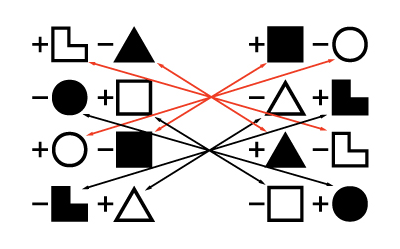Duality relations EII — LSE

1 ↔ 5. Ego block of each partner interacts with the respective superid block of his partner. The ethics (R) information with the plus sign coming from the function 1 of EII is suggesting LSE in the plus area of his function 5. Suggestion by the R element is due to the constant reception of ethics information coming from EII both in verbal (opinions, views, reasoning) and non-verbal (warm friendly looks, warm intonations, soft voice, general appearance of a gentle and accommodating person) forms. LSE in return keeps generating practical logic information (P) both in the shape of practical activity (he always has something to do) and in the shape of thoughts, opinions, views. Both partners are eager to help each other in the field of their respective base functions' elements, however this does not mean that they take on the full load of information processing off their dual's suggestive functions. Besides, this is technically impossible. Dual is perceived as an example of person one wants to become. Because duals have different signs of the respective functions, and in the right ring of social progress interaction is from the plus function 1 to the minus function 5, the duals feel lack of information in the minus area of their suggestive functions. This of course doesn't mean that they desire to get negative relationships or poor quality work. This seeking of the minus information is related to the minus scale quality - globality of approach or comprehension.
2 ↔ 6. Information from the intuitive function of EII activates function 6 of LSE by demonstration of potentialities as his own so situations in which he needs to get clues, understanding of nature and sense of certain events, explanation of reasons of people's behavior. Information from the S function of LSE activates function 6 of EII by LSE's ability to look good and pick up good combination of closing, by his ability to create comfort and look after good condition of people and things. Each partner would like to feel apt and able in the element of his respective function 6 and unconsciously is expecting confirmation of such abilities. Effect of different signs is also present in the interaction of functions 2 and 6. Each of the partners expects more detail and down-to-earth information while his partner's minus function has a tendency to reason, explain and act in the minus zone. It can bring about feeling of lack of the information especially if partner never comes down to the specific matter of the plus sign and especially is the minus is realized not in the scale but in the quality attribute. For example: "your dress looks bad", "it is not nice", "this has no sense", "all this is rubbish" etc. With time functions 2 adapt to partner's needs with respect to sign and duals learn not to touch painful spots of their partner's activation function. Fortunately is not so hard because all they have to do is adapt functioning of their high-dimensional mental track functions.
Partner's superid manifestations look a little childish, and it makes duals have parental attitude: warm and caring. However such a childish behavior can degenerate in egoistic desire only to receive and never give back, because receiving is always more pleasing and the tendency to live at somebody's expense is in the human nature. This represents one of the stumbling stones of dual relations which needs to be realized. Sometimes a mere realization is enough to avoid such a degeneration of relationships (any relationship has potential of either development or degradation).
3 ↔ 7. interaction of functions 3 and 7 causes no conflicts of dimensionality because behavior of the function 3 is usually perceived as "correct". A well trained normative function always meets expectations as from the part of society so from the part of the dual. Taking in consideration that id functions usually do not demand much, there are no reasons for clashes of the functions 3 and 7.
4 ↔ 8. For the same reason there is no conflict between functions 4 and 8 although it might seem that the dual with all the might of his four-dimensional function 8 can squash his partner's function 4. But this does not happen because the individual nature of the id functioning is directed to the needs of the "host". And in the long-term relationships such individual interests begin to include the partner's interests as well. So, LSE considers his dual a subject of protection and care (F). On his part, EII adapts to the peculiarities of the T function of LSE. Such adaptations of id functions are taking place silently (without too much verbalization) and in automatic manner. Of course activity of function 8 cannot be excluded completely but in can be adapted to individual needs. And if such needs presume not hurting one's partner by his fits of aggression directed towards other people, he can train himself ho hold back his impulsive defensive behavior. Similarly if the interests of EII do not include making his partner worry because of his being late, then he can remember that he can give a call to warn about possible delay.
This was description of relations of duals as family couple taking in consideration long-term nature of relationships at close psychological distance. Of course, partners' interaction in conditions of certain work circumstances with consideration of specific IE context of the work environment, different social status and gender situation will have its specific differences.
Together EII and LSE as a dyad form a system with values directed towards "plus" practical logic and "plus" ethics of relations. This system is directed to deepening and refining of relationships as harmonic unity of partners without which is impossible to develop creative potential in the material world.